Microstimulation of the Premotor Cortex of the Cat Produces Phase-Dependent Changes in Locomotor Activity
- PMID: 34289039
- PMCID: PMC8568009
- DOI: 10.1093/cercor/bhab167
Microstimulation of the Premotor Cortex of the Cat Produces Phase-Dependent Changes in Locomotor Activity
Abstract
To determine the functional organization of premotor areas in the cat pericruciate cortex we applied intracortical microstimulation (ICMS) within multiple cytoarchitectonically identified subregions of areas 4 and 6 in the awake cat, both at rest and during treadmill walking. ICMS in most premotor areas evoked clear twitch responses in the limbs and/or head at rest. During locomotion, these same areas produced phase-dependent modifications of muscle activity. ICMS in the primary motor cortex (area 4γ) produced large phase-dependent responses, mostly restricted to the contralateral forelimb or hindlimb. Stimulation in premotor areas also produced phase-dependent responses that, in some cases, were as large as those evoked from area 4γ. However, responses from premotor areas had more widespread effects on multiple limbs, including the ipsilateral limbs, than did stimulation in 4γ. During locomotion, responses in both forelimb and hindlimb muscles were evoked from cytoarchitectonic areas 4γ, 4δ, 6aα, and 6aγ. However, the prevalence of effects in a given limb varied from one area to another. The results suggest that premotor areas may contribute to the production, modification, and coordination of activity in the limbs during locomotion and may be particularly pertinent during modifications of gait.
Keywords: cat; intracortical microstimulation; locomotion; premotor cortex.
© The Author(s) 2021. Published by Oxford University Press. All rights reserved. For permissions, please e-mail: journals.permissions@oup.com.
Figures

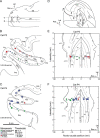


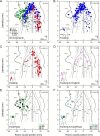

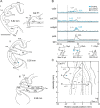
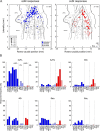
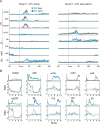

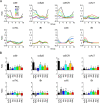
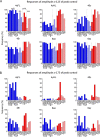

Similar articles
-
Exploring the Consistent Roles of Motor Areas Across Voluntary Movement and Locomotion.Neuroscientist. 2025 Jun;31(3):279-295. doi: 10.1177/10738584241263758. Epub 2024 Jul 23. Neuroscientist. 2025. PMID: 39041460 Free PMC article. Review.
-
Two premotor areas (6aα and 6aγ) involved in motor preparation and execution during visually guided locomotion in the cat.Cereb Cortex. 2025 Jul 1;35(7):bhaf159. doi: 10.1093/cercor/bhaf159. Cereb Cortex. 2025. PMID: 40748337 Free PMC article.
-
Changes in electrical thresholds for evoking movements from the cat cerebral cortex following lesions of the sensori-motor area.Somatosens Mot Res. 2004 Jun;21(2):117-36. doi: 10.1080/08990220410001721275. Somatosens Mot Res. 2004. PMID: 15370092
-
Functional organization within the medullary reticular formation of the intact unanesthetized cat. III. Microstimulation during locomotion.J Neurophysiol. 1991 Sep;66(3):919-38. doi: 10.1152/jn.1991.66.3.919. J Neurophysiol. 1991. PMID: 1753295
-
Contributions of the motor cortex to the control of the hindlimbs during locomotion in the cat.Brain Res Brain Res Rev. 2002 Oct;40(1-3):178-91. doi: 10.1016/s0165-0173(02)00200-x. Brain Res Brain Res Rev. 2002. PMID: 12589916 Review.
Cited by
-
A secondary motor area contributing to interlimb coordination during visually guided locomotion in the cat.Cereb Cortex. 2022 Dec 20;33(2):290-315. doi: 10.1093/cercor/bhac068. Cereb Cortex. 2022. PMID: 35259760 Free PMC article.
-
Exploring the Consistent Roles of Motor Areas Across Voluntary Movement and Locomotion.Neuroscientist. 2025 Jun;31(3):279-295. doi: 10.1177/10738584241263758. Epub 2024 Jul 23. Neuroscientist. 2025. PMID: 39041460 Free PMC article. Review.
-
Two premotor areas (6aα and 6aγ) involved in motor preparation and execution during visually guided locomotion in the cat.Cereb Cortex. 2025 Jul 1;35(7):bhaf159. doi: 10.1093/cercor/bhaf159. Cereb Cortex. 2025. PMID: 40748337 Free PMC article.
-
Auditory Cue Effects on Gait-Phase-Dependent Electroencephalogram (EEG) Modulations during Overground and Treadmill Walking.Sensors (Basel). 2024 Feb 28;24(5):1548. doi: 10.3390/s24051548. Sensors (Basel). 2024. PMID: 38475084 Free PMC article. Clinical Trial.
-
The Cortical Motor System in the Domestic Pig: Origin and Termination of the Corticospinal Tract and Cortico-Brainstem Projections.Front Neuroanat. 2021 Nov 1;15:748050. doi: 10.3389/fnana.2021.748050. eCollection 2021. Front Neuroanat. 2021. PMID: 34790101 Free PMC article.
References
-
- Amos A, Armstrong DM, Marple-Horvat DE. 1990. Changes in the discharge patterns of motor cortical neurones associated with volitional changes in stepping in the cat. Neurosci Lett. 109:107–112. - PubMed
-
- Andujar J-E, Drew T. 2007. Organization of the projections from the posterior parietal cortex to the rostral and caudal motor cortex of the cat. J Comp Neurol. 504:17–41. - PubMed
-
- Andujar J-E, Lajoie K, Drew T. 2010. A contribution of area 5 of the posterior parietal cortex to the planning of visually guided locomotion: limb-specific and limb-independent effects. J Neurophysiol. 103:986–1006. - PubMed
-
- Archibald, F. 2020. Warping using thin plate spines. MATLAB Central File Exchange. https://www.mathworks.com/matlabcentral/fileexchange/24315-warping-using... (last accessed 16 June 2020).
Publication types
MeSH terms
LinkOut - more resources
Full Text Sources
Miscellaneous

